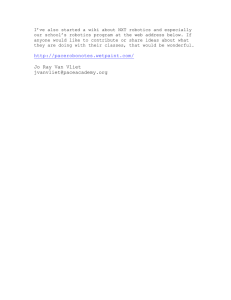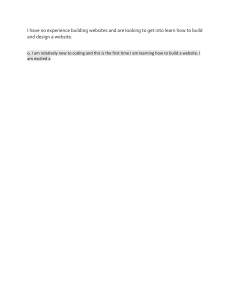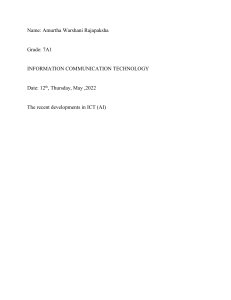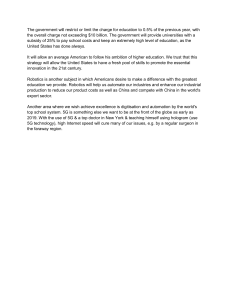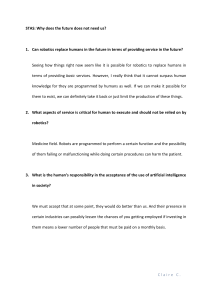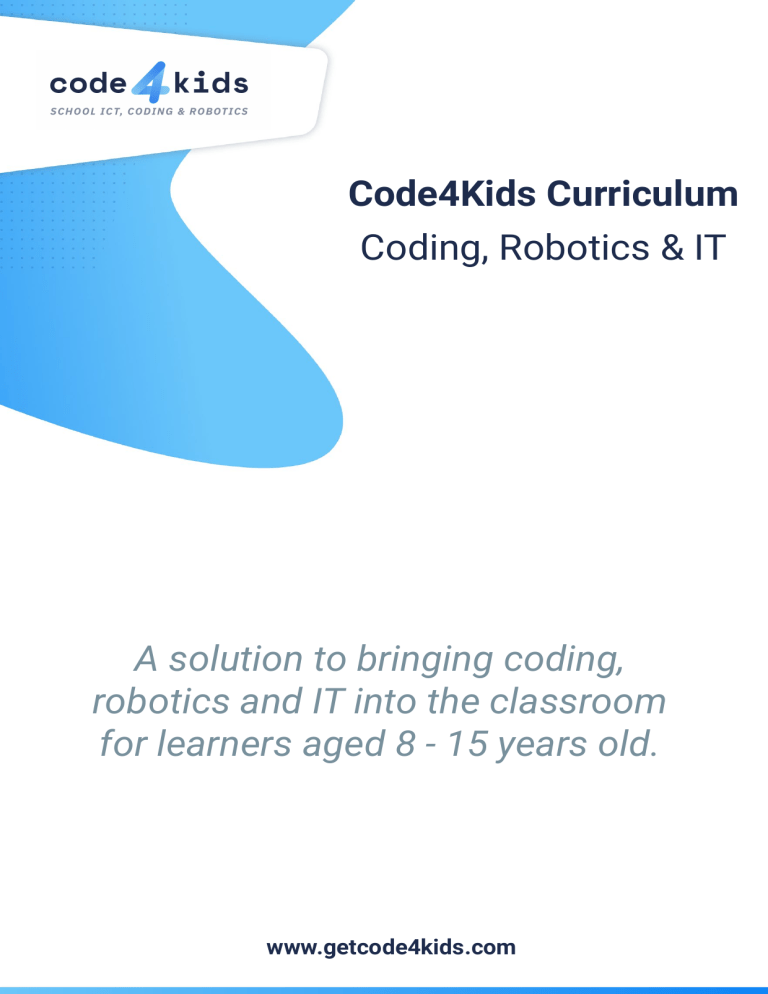
Code4Kids Curriculum Coding, Robotics & IT A solution to bringing coding, robotics and IT into the classroom for learners aged 8 - 15 years old. www.getcode4kids.com Curriculum Map The below curriculum map shows the suggested progress and prerequisites a teacher should follow while delivering Code4Kids to their class. Links are included to teacher training videos, also found on the website. Building Websites and Apps with HTML, CSS and JS Stream: Starting a Year Early Best for: Ages 8-11 2nd year on program Best for: Ages 10-13 3rd year on program Best for: Ages 11-14 use IT and Data Science with sheets/excel and (python) the Start Here HTML & CSS I JAVASCRIPT I ROBOTICS I ICT I My First Website + Projects Tess the Dog + Projects Kipp the Data Manipulation with Spreadsheets HTML & CSS II JAVASCRIPT II World-Class Websites + Projects Tess the Builder + Projects APPS I 4th year on program Best for: Ages 12-15 to Programming robots and drones with Javascript and Python BASICS HTML Basics + Projects 1st year on program Best for: Ages 9-12 How Building Games and Apps with Javascript App Course + Projects GAME DESIGN 1 APPS II GAME DESIGN 1 Curriculum 1. Go by year (Recommended), or 2. Go by stream Robot + Projects ROBOTICS II DRONES I DRONES II + Projects ICT II ICT III ICT IV Code4Kids Core Values: The Purpose of the Curriculum The purpose of the Code4Kids curriculum is to give a guide to teachers, schools and districts around the world on how to teach the emerging field of Coding, Robotics & IT in the classroom to students age 8-15 years old. The curriculum is designed around training and upskilling teachers to be effective in the classroom as well as ensure coding tools and content is relevant to real world applications. The program is designed so that teachers can excite and engage students, meet the needs of parents and amplify the school. 1 Cultivate Confidence With technology set to dominate the economy of the future, the curriculum is designed to cultivate confidence early on in a student's life, to pursue a technology-focused field later in life. 2 Relevant Content Instead of using abstract concepts, students are also learning about topics like their home country, the solar system, recycling or making a website on famous women in history, all the while learning to code. 3 Relevant Tools Students are learning real coding languages and computer tools that employees around the world use every day. Instead of drag-and-drops solutions, learners will become familiar with everything from HTML, CSS, JavaScript to MS Excel and Google Sheets. 4 Teacher-Centric It is a teacher who needs to understand the curriculum and it is the teacher who needs to teach it. Many of the tools, content, and pedagogy discussed in the curriculum is to ensure a teacher, without any required coding background, is able to deliver the curriculum in an effective manner. 5 Bite-Sized Instead of trying to build a website from the bottom up, it is designed from the top down. Meaning that learners see early results, remain engaged and learn core concepts in a pragmatic manner. 6 Real Problem-Solving It's important that teachers understand that they should almost never give a student a direct answer. Students are forced to take ownership of their difficulties and use the tools they have to solve problems themselves. 7 Ever-Improving Unlike many subjects such as mathematics, social science and language, the subject of coding, robotics and computers is a fast-changing subject and Code4Kids endeavours to guide teachers and ensure they are kept on the forefront of the subject. The intention is that this curriculum will give a teacher and school all the answers they need to confidently integrate coding into their curriculum. Code4Kids Standards Alignment Built on the goal of achieving the Code4Kids Core Values (On the previous page) the Code4Kids curriculum aligns to five core international and local standards. For full details on standards alignment see here. There are five pillars that the curriculum aims to align to, and develop within teachers and learners, are: 1. CSTA (US Guide guidelines) 1.1. Computing Systems 1.2. Networks and The Internet 1.3. Data and Analysis 1.4. Algorithms and Programming 1.5. Impact of Computing 2. Key Stage 2 & 3 (UK computer curriculum) 2.1. Digital Literacy 2.2. Computer Science 2.3. Information Technology 3. CAPS (South African Core Curriculum), Interleaving with: 3.1. STEAM (Science, Technology, Engineering, Arts, Mathematics) 3.2. CAT (Computer Applications Technology) 3.3. Language, Geography, History (World and South Africa) 4. W3C & Core Programing Languages and Concepts. 4.1. HTML & CSS 4.2. Javascript 4.3. Python 4.4. Robotics 4.5. ICT (Excel / Sheets) 5. ISTE (International Society for Technology in Education) 5.1. Empowered Learner 5.2. Digital Citizen 5.3. Knowledge Constructor 5.4. Innovative Designer 5.5. Computational Thinker 5.6. Creative Communicator 5.7. Global Collaborator Time Allocation, Duration and Age ● ● ● The curriculum is intended to span four years being taught for one hour per week, in the school classroom. (Variations can occur from 2x 1 hour per week, to 1x 30 min per week.) The curriculum and content makes up 40-60 hours with various Project Based Learning (PBL) which can extend the duration. The curriculum and content is designed to be relevant, and intended for, any learner to begin with from between 8-15 years old. What is Coding, Robotics and IT. At its core, coding is simply the languages we, as humans use, to speak to computers. Coding is how we make computers do the things we want them to do. Robotics and IT the same. However, coding is far more than just a group of languages. Coding, Robotics and IT are powerful tools that can be used to teach learners creative problem solving and attention to detail, as well as building the resilience in learners to try, fail and try again with an improved understanding. Note: In this context, the word coding and programming are interchangeable; “I am programming a computer to do what I want it to do”, “I am coding a computer to do what I want it to do.'' What is Coding? As in the image above. On the left hand side we are speaking to a computer in a language it understands, and on the right hand side, we see the interpretation of what the computer understands. That is all coding is, us speaking to the computer in the language it understands. By changing the background-color on line 2 to pink, we see the computer understands us, and has made the change. The entire curriculum focuses on learners being able to manipulate a computer to get it to do the things the learner wants it to do. What is Robotics? What is robotics? This is a really good question, and before embarking on a journey of teaching robotics it is important to take a closer look at what robotics actually is. There are three core concepts to robotics: 1. Actuators, i.e. things that move. E.g. an engine that might power the wheels of a car, an electric motor, a sliding-door or pneumatics etc. 2. Sensors, i.e. things that try to understand the world around them. E.g. a proximity sensor that beeps when your car is too close to someone else, a motion detector, or a light sensor etc. 3. Processors, i.e. the logic that connects sensors and actuators. A processor will take information from sensors and gives commands to the actuators. For example your car might sense that it is too close to something with a proximity sensor (sensor) and the processor then will engage the branks (actuator). It is a process where we might see a statement like: “If this happens then make sure to do this” (If too close then pull the breaks) Note: When teaching robotics, the Code4Kids curriculum uses an inexpensive ways to teach and practice robotics all based in a web browser. One does not need a physical robot-like device to teach robotics and importance concepts. The browser based software also has advantages in that it can extend a students imagination and creativity. What is IT? A significant portion of the curriculum (25%) focuses are familiarising students with various aspects of IT, from MS Excel and Google Sheets, to graphic design and engineering drawing. The curriculum focuses not only on using these powerful, everyday tools, but really digging into how a we can use these tools to; manipulate large sets data, save time, teach yourself or represent data in ways that are useful to humans. As an example, the ability for a student to be comfortable with a program like Excel will put them leaps ahead in any field they pursue, whether or not seemingly technical. Pedagogy Overview The most important cog in a students learning journey is not the content or software it is the teacher. The curriculum is designed to be centered around upskilling and supporting a teacher to be as confident and effective as possible. As a teacher it is very important to understand that a coding, robotics and IT lesson is a different environment to many other subjects. It might feel more like an art class, but with problem solving in a very collaborative environment. The Code4Kids content and curriculum is designed to avoid a student putting their headphones on and disappearing. The curriculum is designed to encourage team work, with students doing both the asking and teaching. Each lesson is structured to have a brief introduction from the teacher before the students will launch into their first tasks. As the lesson progresses the teachers role becomes more one of guidance, challenging the stronger students and encouraging the slower students. Each lesson is designed to cover core concepts in the first 50-70% of the lesson which every student should be able to complete, the next 20-30% is intended to be more challenging and the last 20-10% is designed to be exponentially more difficult. The advantage of this is two-fold (1) a teacher will never have some students speeding far ahead of the class, they will rather challenge themselves further on the same subject matter and (2) students will never be bored or have a lack of challenge. Code4Kids have a very important concept called the 3 Step Problem Solving Approach. The single most important thing to understand as a teacher is that a teacher must never give the answer. Instead, patiently follow the following narrative whenever a student is stuck: ● ● ● Step 1: Has the student tried? Can a teacher see the student has tried, attempted the problem, made a mistake? If not, all you are required to do is tell them to read the question and try, it is critically important that a teacher see’s typing, or an attempt. If they have tried, step 2: Step 2: Has the student asked their neighbour? A student MUST ask their neighbour for help, and when the neighbour helps they can only do so with their Mouth But No Mouse (An important Code4Kids value worth printing and putting on the wall of the computer lab). This is where there is a powerful collaborative environment a teacher can create. The curriculum wants students to become teachers, team workers, humble, patience and kind people willing to teach. If they have asked their neighbour but they are still stuck (technically everyone in the class is stuck), then move onto step 3. Step 3: Answer only in the socratic method. This means answering the students question with a question of your own, i.e. what if you try this? What if you do that? Why did you write that? The advantage of this process is it means that a teacher will never have to have all the answers. The Code4Kids curriculum is especially designed to be taught by a teacher without any prior coding background. There are always students who catch onto the content quickly, and it is a teacher's job to leverage the understanding of those students to guide their computer neighbours. As an example: When a teacher encounters a faster student and encourages them to assist their neighbours it is recommended that the teacher ensures the stronger student is teaching correctly, and guides the student in the following way to become a better teacher: (i) ensure they are not doing it for their neighbour (Mouth But No Mouse) (ii) are learning how to teach humbly by not coming across arrogant or know-it-all as they have already completed it and (iii) are patient with their classmates as they guide them. National Standards The curriculum is constantly being further align to your national standards in terms of core content and concepts being covered.
